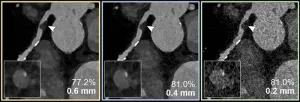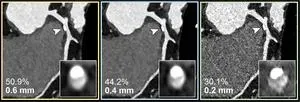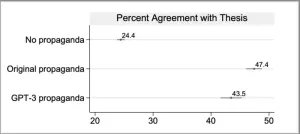(Press-News.org) OAK BROOK, Ill. – Ultrahigh-spatial-resolution photon-counting detector CT improved assessment of coronary artery disease (CAD), allowing for reclassification to a lower disease category in 54% of patients, according to a new study published today in Radiology, a journal of the Radiological Society of North America (RSNA). The technology has the potential to improve patient management and reduce unnecessary interventions.
Coronary CT angiography is a first-line test in the assessment of coronary artery disease. However, its diagnostic value is limited in patients with severe calcifications, or calcium buildup in the plaque of the coronary arteries.
Ultrahigh-spatial-resolution photon-counting detector CT (PCD-CT) improves image quality compared to conventional CT. Additionally, it provides better spatial resolution, or the ability to differentiate two adjacent structures as being distinct from one another.
“Our study provides a glimpse into the potential impact of performing coronary CT angiography using ultrahigh spatial resolution technology on risk reclassification and recommended downstream testing,” said study co-author Tilman Emrich, M.D., attending radiologist at the University Medical Center Mainz in Germany, and assistant professor of radiology at the Medical University of South Carolina in Charleston.
For the study, researchers evaluated coronary stenoses, or narrowing in the coronary arteries, in a vessel phantom (in-vitro) containing two different stenosis grades (25%, 50%), and retrospectively in 114 patients (in-vivo) who underwent ultrahigh-spatial-resolution cardiac PCD-CT for the evaluation of coronary artery disease. In-vitro values were compared to the phantom’s manufacturer specifications, and patient results were assessed regarding effects on coronary artery disease reporting and data system reclassification (CAD-RADS).
“The study used a combination of artificial vessel models and real-world patient data,” Dr. Emrich said. “It simulated three types of reconstructions from a single PCD-CT scan, resembling conventional CT, high-resolution, and ultrahigh-spatial-resolution scans. Observers evaluated the severity of stenosis and generated CAD-RADS classifications, guiding further patient management decisions.”
In-vitro results demonstrated a reduced overestimation of the stenosis by ultrahigh-spatial-resolution scans by reducing the adverse effects of the calcifications on the image.
Results from the patients with suspected or diagnosed coronary artery disease confirmed a lower median degree of stenosis for calcified plaques (29% vs. 42%) with ultrahigh-spatial-resolution PCD-CT compared to standard CT. Ultrahigh-spatial-resolution often led to patients being reclassified to a lower CAD-RADS category. Of the 114 patients, 54% were given a lower CAD-RADS classification than they were originally assigned. The researchers found in-vitro quantification of the 193 coronary CT angiography-based stenoses was also more accurate using ultrahigh-spatial-resolution than standard resolution.
“We found that ultrahigh-spatial-resolution reconstructions resulted in significant changes in recommendations for over 50% of patients,” Dr. Emrich said. “The impact was particularly notable in cases with calcified plaques, where ultrahigh-spatial-resolution reduced the overestimation of stenosis.”
Dr. Emrich explained that ultrahigh-spatial-resolution may address the current limitations of conventional cardiac CT angiography by reducing the overestimation of stenosis due to calcium blooming, an effect which can cause small, high-density structures—such as calcifications—to appear larger than their true size.
“This could significantly alter recommendations for downstream testing, potentially leading to a reduction of unnecessary procedures (and their potential complications) and reduced healthcare costs,” he said.
No substantial benefits of ultrahigh-spatial-resolution were observed for mixed and non-calcified plaques.
“It is important to note that these findings are from a simulation study, and further validation is needed in real-world comparisons,” Dr. Emrich said.
###
“Ultrahigh-Spatial-Resolution Photon-counting Detector CT Angiography of Coronary Artery Disease for Stenosis Assessment.” Collaborating with Dr. Emrich were Moritz C. Halfmann, M.D., Stefanie Bockius, M.D., Michaela Hell, M.D., U. Joseph Schoepf, M.D., Gerald S. Laux, M.D., Larissa Kavermann, M.D., Dirk Graafen, M.D., Tomasso Gori, M.D., Ph.D., Yang Yang, M.D., Roman Klöckner, M.D., Pál Maurovich-Horvat, M.D., Ph.D., Jens Ricke, M.D., Lukas Müller, M.D., Akos Varga-Szemes, M.D., Ph.D., and Nicola Fink, M.D.
Radiology is edited by Linda Moy, M.D., New York University, New York, N.Y., and owned and published by the Radiological Society of North America, Inc. (https://pubs.rsna.org/journal/radiology)
RSNA is an association of radiologists, radiation oncologists, medical physicists and related scientists promoting excellence in patient care and health care delivery through education, research and technologic innovation. The Society is based in Oak Brook, Illinois. (RSNA.org)
For patient-friendly information on CT angiography, visit RadiologyInfo.org.
END
OAK BROOK, Ill. – Annual breast cancer screening beginning at age 40 and continuing to at least age 79 results in the highest reduction in mortality with minimal risks, according to a new study published today in Radiology, a journal of the Radiological Society of North America (RSNA).
Breast cancer is the second most common cause of cancer death for women in the U.S. Despite research demonstrating that consistent participation in screening mammography can reduce breast cancer deaths by 40%, only 50% or less of eligible women actually participate in annual screening.
“There is an ongoing debate over the recommendations for breast cancer screening, specifically ...
Two New York University faculty have been awarded fellowships from the Alfred P. Sloan Foundation: SueYeon Chung, an assistant professor at the Center for Neural Science, and Jinyoung Park, an assistant professor at the Courant Institute for Mathematical Sciences.
The fellowships recognize “exceptional U.S. and Canadian researchers whose creativity, innovation, and research accomplishments make them stand out as the next generation of leaders,” the Sloan Foundation said in announcing this year’s ...
A recent study led by Assistant Professor Lindsay Jibb of the Lawrence Bloomberg Faculty of Nursing and Scientist at The Hospital for Sick Children (SickKids) found that parents of young children with cancer, along with pediatric cancer clinicians are in favour of an app-based solution that Jibb and her team are creating, to help parents manage their child’s cancer pain at home.
The study published in PLOS Digital Health showed that parents and clinicians not only found the pain management app to be helpful and safe, but also provided them with a sense of empowerment.
“The ...
BINGHAMTON, N.Y. -- The way companies announce new products or build up hype can often influence their success once those new products hit the market, according to new research from Binghamton University, State University of New York. Whether it's an upcoming blockbuster movie or a new rollout from major companies like Coca-Cola or Apple, the new research shows how companies might use this type of preannouncement marketing to their advantage.
How often have you watched trailers for an upcoming movie and thought, “I can’t wait to see that,” when it hits theaters ...
Our immune system is remarkably powerful. It quickly assembles teams of cells to eliminate threats inside our bodies. But sometimes, it hits the wrong target. Autoimmune diseases like lupus and multiple sclerosis result from friendly fire—immune cells attacking healthy tissues and organs by mistake. New treatments and therapeutic targets are direly needed for these conditions.
Now, Cold Spring Harbor Laboratory (CSHL) Professor Christopher Vakoc may have stumbled upon a new therapeutic target—one hidden in plain sight. Vakoc and his team discovered that IκBζ, a well-studied protein in the immunology ...
PITTSBURGH, Feb. 20, 2024 — Buprenorphine, a life-saving medication for opioid use disorder, is far less accessible in geographic areas of the United States with racially and ethnically diverse populations than in predominantly white areas, according to a new study of pre-pandemic data led by health policy scientists at the University of Pittsburgh School of Public Health published today in Journal of Addiction Medicine.
The study is among the first to examine buprenorphine access at the local, sub-county level, and the findings point to lack of access to medications for opioid use disorder as a potential ...
In an editorial, Sethuraman Panchanathan, director of the U.S. National Science Foundation (NSF), calls for the responsible and equitable development of artificial intelligence (AI) and promises to use the agency’s resources to work toward democratizing AI research. NSF spends $800 million on AI research in the public interest each year. Panchanathan summarizes some of the benefits AI can offer to scientific research—from accelerating discovery to automating routine tasks—but emphasizes that AI must be safe and accessible. Toward that end, NSF and its partners launched the National Artificial Intelligence Research Resource ...
Many animals, including apex predators, move in groups. We know this collective behavior is fundamental to the animal’s ability to move in complex environments, but less is known about what drives the behavior because many factors underlie its evolution. Scientists wonder, though, if all these animals share a fundamental drive such as for mating, safety, or perhaps even to save energy.
“The keyword is perhaps,” said Yangfan Zhang, postdoctoral researcher in the Department of Organismic and Evolutionary Biology (OEB) at Harvard, “because no one has actually measured this and compared it directly across all animal groups, mainly ...
One in three police homicides could have been avoided without endangering police or the public, according to a study. Eight percent of all homicides of adult men in the United States are committed by police. Using data from 2008–2017 from the National Officer-Involved Homicide Database, Josh Leung-Gagné compared police homicide rates across the 711 local police departments serving 50,000 or more residents in the United States. One explanation for differing rates of police killings is that some jurisdictions are riskier than others, which necessitates ...
Research participants who read propaganda generated by the AI large language model GPT-3 davinci were nearly as persuaded as those who read real propaganda from Iran or Russia, according to a study. Josh Goldstein and colleagues identified six articles, likely originating from Iranian or Russian state-aligned covert propaganda campaigns, according to investigative journalists or researchers. These articles made claims about US foreign relations, such as the false claim that Saudi Arabia committed to help fund the US-Mexico border wall or the false claim that the US fabricated reports showing that the Syrian government had used chemical weapons. For each ...







